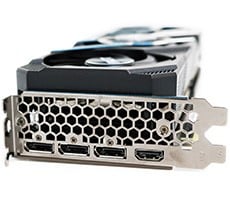NVIDIA GeForce 7800 GTX
|
We have two final data points to cover before we bring this article to a close. Throughout all of our benchmarking, we monitored how much power our test system was consuming using a power meter and also set up a sound level meter about six inches away from the graphics card. Our goal was to give you all an idea as to how much power each configuration used and to explain how loud the high-end configurations were under load. Please keep in mind that we were testing total system power consumption, not just the power being drawn by the video card alone.

As we mentioned earlier, NVIDIA claimed the GeForce 7800 GTX (G70) was not only faster than the GeForce 6800 Ultra (NV40), but that its performance per watt was much better. After testing this claim for ourselves, we can safely say NVIDIA wasn't stretching reality. With a single GeForce 7800 GTX installed in our test system, we found it drew less power than either GeForce 6 Series card we tested at idle, and it drew only marginally more power while under load (we measured power while looping 3DMark05). The GeForce 7800 GTX SLI configuration, however, drew less power than a similar 6800 Ultra SLI setup both at idle and while under load. You may question how a pair of 7800 GTX cards can draw less power than a pair 6800 Ultras when the 7800 GTX drew more power in a single card setup, but you have to remember that with an SLI rig, the CPU becomes a larger bottleneck because the graphics sub-system has more fillrate and memory bandwidth at its disposal. Each card in the 7800 GTX SLI configuration wasn't working quite as hard as it was in the single card configuration, so each card drew slightly less power. If we had a test that taxed each GPU in an SLI setup equally, 100% of the time, the 7800 GTX SLI rig would likely draw more power than a similar setup using GeForce 6800 Ultras.
Our sound level meter had surprisingly little to tell us, due to the fact that our CPU cooler (ThermalTake SilentBoost K8), PSU (Enermax NoiseTaker), and dual 120mm case fans drowned out the noise produced by the video cards. Disregarding the extra noise some cards produced while the test system was going through its POST, there was very little difference between them. With the Radeon X850XT Platinum Edition installed, our sound level meter registered a peak of 65db, which was the same level we measured with a single GeForce 7800 GTX installed. With a pair of GTX cards installed, sound levels peaked at about 66db. Only when we had a pair of 6800 Ultras installed did we see the noise meter's needle jumping. With a pair of GeForce 6800 Ultras running, sound levels peaked at about 70db.







